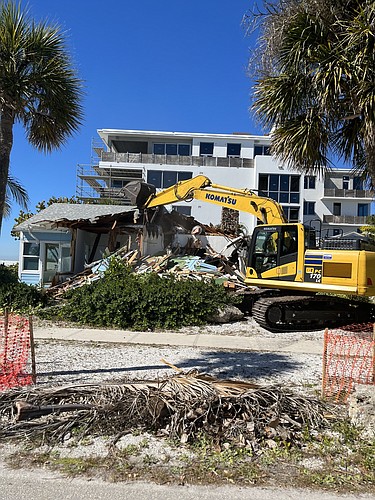- April 19, 2024
-
-
Loading

Loading

The former home of Capt. Ralph Styles, who survived the attack on Pearl Harbor in 1941, was demolished last week on Siesta Key. Although the home no longer stands, the nightly flag ceremony there has continued.
Ralph Styles retired and moved to Siesta Key in the early 1960s. After a lengthy career in the Navy, the home was a dream come true for him and his wife, said his daughter, Annie.
“My mother loved that house. It was the little cottage by the sea that they always dreamed of,” Annie said. “Then the flag ceremony became a spontaneous neighborhood thing. He’d put the flag up in the morning, down at night and the neighbors starting joining him.”
The flag ceremony began as a simple symbol of appreciation for the armed forces and became more intricate as time passed. Ralph found a bugler and a retired Army drummer who also lived on Siesta Key, both of whom happily joined in the tradition.
The ceremony was halted after Ralph's death in 2009 but was restarted near Beach Access 2 in 2017. Annie said she appreciates the ceremony but was sad to see the house, and all that it represented, get destroyed.
“At one point in time, our neighborhood was cohesive and very pleasant. We all knew each other,” she said. “It was hard to see my dad’s house get destroyed. It sort of represented that cohesiveness in the community.”
The property on which the home stood at 99 Beach Road was first sold in 2009. There were efforts to preserve, relocate and renovate the home, but no agreement was made to do so.
Despite the home’s destruction, a plaque honoring Ralph can be found on Siesta Key that outlined his career, accomplishments and significance, both on the Key and as a member of the military.
“There was a group on Siesta Key trying to preserve the house,” Annie said. “They thought it might be the oldest house on the Key. They were planning to move it to one of the beach accesses to use as a public building but that was turned down.”
Originally from North Carolina, Ralph planned to become a lawyer. He had never seen the ocean until he graduated from the Naval Academy in 1933, said Annie.
Ralph worked as a submarine engineer at the beginning of World War II. But he quickly moved up the ranks and captained the Sea Devil submarine, where he achieved some of his most heroic accomplishments.
“He was the captain of the Sea Devil in the South Pacific. It was during that time his submarine damaged 12 Japanese ships so badly that they could no longer be used during the war,” Annie said.
Two Navy Crosses were awarded to Ralph. Ironically, his Siesta Key home was originally painted battleship grey before it was later repainted pale blue.
Although she was present with her father during the Pearl Harbor attacks, Annie said she only faintly remembers the day. Rather, she has remembered the war through family stories and a piece of a bombshell that she has kept throughout her life.
“We have a little piece of bombshell that came through our window. I keep it framed in my house up north,” she said. “It took awhile for them to understand what had happened at Pearl Harbor, and after that we didn’t see much of my father during the years of the war.”
Although she could not recall from personal memory, she described the bravery of her father during the Pearl Harbor attacks. She said that because the Pearl Harbor channel was narrow, the Navy could not risk getting bombed while in it and were forced to stay in place.
After the bombing seemed to cease, Ralph and his unit went out to retaliate without knowing what had happened to their families. Despite the life-threatening situation, the Styles family was reunited and transitioned with the war.
“They were overlooking Pearl Harbor and saw little puffs of smoke. They asked the main operator why the Navy was doing maneuvers on a Sunday,” Annie said. “But they were told they weren’t doing any maneuvers.
“They thought if there would be an attack anywhere it would be the Philippines, they never imagined it would be Hawaii."
The family moved frequently while Ralph was in the war. Annie said she attended 10 different schools during her childhood, which was not always an easy transition.
Now a resident of Siesta Key, Annie also has a home in Massachusetts. She has three sons, one of whom lives in Tokyo.
“It’s very interesting because my husband’s father was one of the 42 original people on the Manhattan Project,” Annie said. “So my son has two grandpas involved with the Japanese in a different kind of way.”
The Manhattan Project was a World War II-era research project that helped create the first atomic bombs. The project involved the U.S., the U.K. and Canada and began in response to the Pearl Harbor attacks.
The flag ceremonies on Siesta Key are free and open for the public to attend at 8 a.m. and at sunset. Ceremonies include music, presentations and recognitions of military members.
“Seeing the flag ceremony back has been such a beautiful thing to see,” Annie said. “It also draws quite the crowd sometimes, especially during the high seasons.”